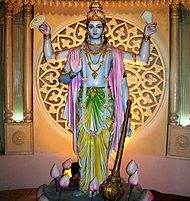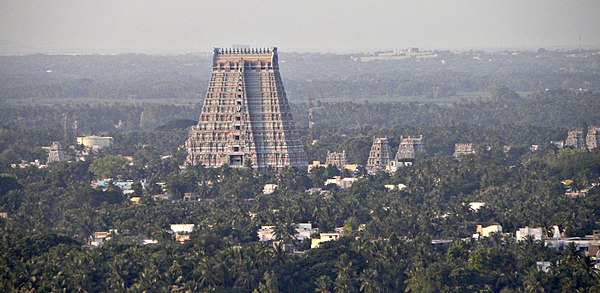Vishnu also known as Narayan and Hari, is the preserver of creation among the Hindu trinity of supreme divinity( Brahma ,Vishnu and Shiva).
He is the supreme personality of Godhead within Vaishnavism, one of the major sects within Hinduism.
He is responsible for maintaining the cosmic balance, and to protect all realms of existence.
Whenever the world is overpowered by evil and destructive forces, Vishnu descends on Earth as a divine manifestation( avatar) to restore Dharma and uplift righteousness. Known to be benign(kind) and forgiving, Lord Vishnu grants Moksha ( liberation from cycle of birth and death) to his devotees. He dwells in the heart of all human being showing them the right way . He is omnipresent and all-pervasive.
Origin of Vishnu

The name Vishnu means “All-pervasive” ( the one who is everywhere). The one who is free from bondage of Maya is Vishnu. He existed before the creation of universe .
According to Vishnu Purana ,before the creation of universe began there existed only a endless ocean, in which omniscient Vishnu was sleeping on the coils of Adishesha ( celestial snake with a thousand heads).
Brahma emerged from a lotus flower that spring up from the navel of Vishnu. Brahma created the universe and all the people to populate it.
So Vishnu is Swayambhu , unborn and unmanifested.He is sometimes mapped to the Sattva Guna .
Vaishnavism considers Vishnu to be the supreme God, one who is transcendental, unchanging,limitless, and the soul (Atman) of the universe – the ‘Parabrahman’ .
Appearance and Attributes
Vishnu is depicted as a dark blue compexioned God dressed with jwelleries and reclining on the coils of serpent Sheshnaga. He has four arms in which he holds different objects depicting his different aspects.
1.Panchajanya
Panchajanya is the divine conch of Vishnu .It is a symbol of creative aspects of him and his knowledge. A primordial sound of ‘Om’ emanates from the conch , when blown. It is spiral in shape symbolising the interconnection of cyclic existence.It was blown by Krishna to begin the Kurukshetra war.
2.Sudarshana
Sudarshana is the Chakra( discuss) of Vishnu . It is the most powerful celestial weapon , capable of destroying the entire universe.It is a symbol of righteousness. It was used by Krishna in Mahabharata several times.
‘ Su’ means auspicious and ‘darshan’ means vision.It has 108 serrated blades, six spokes and three layers( symbolising past ,present and future).

3.Kaumodaki
Kaumodaki is the mace of Vishnu ,symbolising physical strength. It is also a symbol of authority and power of knowledge.Kaumodaki can numb the mind , and is used by Vishnu to remove illusions and awaken spirituality in human beings.
4.Padma
Vishnu holds a lotus called Padma, in his hand symbolizing purity ,prosperity and transcendence. It is a depiction that Vishnu beholds the souls of all living creatures.
Vishnu is also depicted to hold a bow(Sharanga), a sword ( Nanadaka) , necklace with Kaustubh gem, wearing a garland named Vaijyanti.
On his chest is a mark of Srivatsa , which is formed by coiling of his golden colored chest hair. It is a symbol of infinite and limitless nature of Vishnu.
Reference from Scriptures
Vishnu is a prominent deity from Vedic period or even since the pre-vedic period.
Five out of 1028 hymns of Rigveda are dedicated to Vishnu. Although he is reverred in several other hymns which are dedicated to Indra , Agni and others.
According to Vedas , Vishnu resides in the highest place where the self conscious Brahman resides.
Reference from The four Vedas

Vishnu is revered in the Brahmana( most important ) layer of the text. He is linked to prominent deities of Vedic period like Indra and Surya.
Mandal 7 of Rigveda , describes Vishnu as the God who separates heaven and earth.
Elsewhere in Rigveda and Atharvaveda, Vishnu is equivalent to Prajapati ( a Vedic diety who is the creator and preserver of Universe, often associated to Brahma).
Rigveda: Seven germs unripened yet are heaven's prolific seed: their functions they maintain by Vishnu's ordinance. Endued with wisdom through intelligence and thought, they compass us about present on every side. They call him Indra, Mitra, Varuna, Agni, and he is heavenly-winged Garutman. To what is One, sages give many a title.
Narayan Sukta of Yajurveda describes Vishnu as the supreme being .According to these verses Vishnu has the Param padam ( the highest position ) and he resides in his Vaikuntha (Param Dham). Rigveda also confirms this.
Rigveda describes the three steps ( Trivikrama) of Vishnu as Vamana avatar:
RIGVEDA: विष्णोर्नु कं वीर्याणि प्र वोचं यः पार्थिवानि विममे रजांसि । यो अस्कभायदुत्तरं सधस्थं विचक्रमाणस्त्रेधोरुगायः ॥१॥… viṣṇōrnu kaṃ vīryāṇi pra vōcaṃ yaḥ pārthivāni vimamē rajāṃsi | yō askabhāyaduttaraṃ sadhasthaṃ vicakramāṇastrēdhōrugāyaḥ ||1|| I will now proclaim the heroic deeds of Visnu, who has measured out the terrestrial regions, who established the upper abode having, wide-paced, strode out triply…
The Shatapatha Brahmana( one of the most systematic commentary of Yajurveda ,describing Vedic rituals and sacrifices), Narayana says :
“All the worlds have I placed within mine own self, and my own self has I placed within all the worlds.”
The text almost coincides with the teachings of Vaishnav tradition, considering Vishnu to be the supreme self .
It describes Vishnu as the knowledge of Vedas, the essence of everything , the principles of universe, that which is imperishable and endless is Vishnu .
He is ever-present within living beings as an intrinsic property of all.
Other than Vedas, the Vaishnav Upanishads descibes the incarnation of Vishnu like Rama and Krishna as the supreme reality – the ‘Brahman‘.
Reference from Puranas

The major Vaishnav Puranas like Bhagvat Purana, Vishnu Purana , Garuda Purana, Vayu Purana and Naradeya Purana, Vishnu is described as the almighty and the supreme being , who has created everything by his own energy.
These texts also describes the various names given to Vishnu like Hari,Narayana, Achyuta,Keshav, vasudeva etc.
When there is decline in righteousness ,truth re-emerges as the Vishnu avatar first makes peace with the demons, understands them and then creatively defeats them, bringing back hope, justice, freedom and good – a cyclic theme that appears in many legends.
According to Vaishnav tradition , at the end of the universe Vishnu dissolves all of his creation within himself and recreates them . This is a cyclic process.
However this concept is contradicted by Shaivism and Shaktism , where Shiva and Shakti are the supreme being respectively.
Lakshmi
Lakshmi is the consort of Vishnu . She is the Goddess of fortune and prosperity .
When Vishnu incarnates on earth ,Lakshmi also incarnates as her female companion. For example – Rama and Sita , Krishna and Rukmini ( Radha is considered as the personification of Krishna himself due to her deepest form of love for him).
Vishnu in the form of Venkateshwara ( Tirupati Balaji) is seen with his consort Padmavati ( an avatar of Lakshmi).
Other than Lakshmi Vishnu is also specially related to:
(i).Garuda – Garuda is an divine eagle and the mount of Vishnu.
(ii).Vishwaksena– He is the commander of Narayana’s army.
(iii).Harihara – He is the merged form of shiva and vishnu, sometimes also called Harirudra (in Mahabharat).
(iv).Narkasura– Son of Bhudevi and Varaha ( vishnu incarnation) . He was a Asura king and was killed by Krishna.
(v).Kaamdeva – Son from Lakshmi and Vishnu, he is the god of love and desire and husband of Rati.
(vi).Ayappa -Son from Mohini ( female form of Vishnu ) and shiva, born to kill Mahishi a demoness ( sister of Mahishasura, a demon killed by Durga).
Dashavatars- Ten Incarnations of Vishnu

Vishnu is mostly worshipped in his ten form or ten human manifestations , which are collectively called Dashavatars.
Although most of the scriptures presents the same list of these ten forms ,but the presence of Buddha is contradicted by Shiva Purana.
The most common names are as follows:
Shanti Parva, Mahabharata Appearing in the forms of a swan [Hamsa], a tortoise [Kurma], a fish [Matsya], O foremost of regenerate ones, I shall then display myself as a boar [Varaha], then as a Man-lion (Nrisingha), then as a dwarf [Vamana], then as Rama(Parshuram) of Bhrigu's race, then as Rama, the son of Dasaratha, then as Krishna the scion of the Sattwata race, and lastly as Kalki.
Krishna and Ram are the most prominently worshipped incarnations.
Other than these incarnation Vishnu is also believed to have many other forms which are worshipped regionally in India, for example Lord Venkateshwar, Thirumal and so on.
Temples and Worship
Vishnu temples and iconography existed probably before 1st millennial BCE.
The Dashavatara temple in Deogarh( near to Jhansi), Uttarpradesh , is a 6th century temple of Vishnu .
Most of the vishnu temples are dated back to Gupta period.
Other famous temples of Lord Vishnu or his incarnations are :

1.Badrinath Temple, Badrinath 2.RanganathSwamy, Srirangam 3.Padmanabhaswami temple,Trivendrum 4.Venkateshwara temple, Tirumala 5.Jagannath temple ,Puri 6.Dwarikadhish temple,Dwarika
Vishnu is also mentioned in Budhism, Shikhism, and Jainism. He is also worshipped in Indonesia , but with different traditions and different legends linked to him.
The aim of life is an inquiry into the Truth, and not the desire for enjoyment in heaven by performing religious rites, Those who possess the knowledge of the Truth, call the knowledge of non-duality as the Truth,they are called Brahman , the highest self , the Bhagvan. ----Bhagvat Purana: